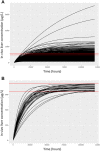Derivation of a Human In Vivo Benchmark Dose for Perfluorooctanoic Acid From ToxCast In Vitro Concentration-Response Data Using a Computational Workflow for Probabilistic Quantitative In Vitro to In Vivo Extrapolation
- PMID: 34045957
- PMCID: PMC8144460
- DOI: 10.3389/fphar.2021.630457
Derivation of a Human In Vivo Benchmark Dose for Perfluorooctanoic Acid From ToxCast In Vitro Concentration-Response Data Using a Computational Workflow for Probabilistic Quantitative In Vitro to In Vivo Extrapolation
Abstract
A computational workflow which integrates physiologically based kinetic (PBK) modeling, global sensitivity analysis (GSA), approximate Bayesian computation (ABC), and Markov Chain Monte Carlo (MCMC) simulation was developed to facilitate quantitative in vitro to in vivo extrapolation (QIVIVE). The workflow accounts for parameter and model uncertainty within a computationally efficient framework. The workflow was tested using a human PBK model for perfluorooctanoic acid (PFOA) and high throughput screening (HTS) in vitro concentration-response data, determined in a human liver cell line, from the ToxCast/Tox21 database. In vivo benchmark doses (BMDs) for PFOA intake (ng/kg BW/day) and drinking water exposure concentrations (µg/L) were calculated from the in vivo dose responses and compared to intake values derived by the European Food Safety Authority (EFSA). The intake benchmark dose lower confidence limit (BMDL5) of 0.82 was similar to 0.86 ng/kg BW/day for altered serum cholesterol levels derived by EFSA, whereas the intake BMDL5 of 6.88 was six-fold higher than the value of 1.14 ng/kg BW/day for altered antibody titer also derived by the EFSA. Application of a chemical-specific adjustment factor (CSAF) of 1.4, allowing for inter-individual variability in kinetics, based on biological half-life, gave an intake BMDL5 of 0.59 for serum cholesterol and 4.91 (ng/kg BW/day), for decreased antibody titer, which were 0.69 and 4.31 the EFSA-derived values, respectively. The corresponding BMDL5 for drinking water concentrations, for estrogen receptor binding activation associated with breast cancer, pregnane X receptor binding associated with altered serum cholesterol levels, thyroid hormone receptor α binding leading to thyroid disease, and decreased antibody titer (pro-inflammation from cytokines) were 0.883, 0.139, 0.086, and 0.295 ng/ml, respectively, with application of no uncertainty factors. These concentrations are 5.7-, 36-, 58.5-, and 16.9-fold lower than the median measured drinking water level for the general US population which is approximately, 5 ng/ml.
Keywords: bayesian; in silico; in vitro; physiologically based kinetic; reverse dosimetry.
Copyright © 2021 Loizou, McNally, Dorne and Hogg.
Conflict of interest statement
The authors declare that the research was conducted in the absence of any commercial or financial relationships that could be construed as a potential conflict of interest.
Figures




Similar articles
-
Derivation of a Human In Vivo Benchmark Dose for Bisphenol A from ToxCast In Vitro Concentration Response Data Using a Computational Workflow for Probabilistic Quantitative In Vitro to In Vivo Extrapolation.Front Pharmacol. 2022 Feb 11;12:754408. doi: 10.3389/fphar.2021.754408. eCollection 2021. Front Pharmacol. 2022. PMID: 35222005 Free PMC article.
-
A novel method to derive a human safety limit for PFOA by gene expression profiling and modelling.Front Toxicol. 2024 Mar 21;6:1368320. doi: 10.3389/ftox.2024.1368320. eCollection 2024. Front Toxicol. 2024. PMID: 38577564 Free PMC article.
-
A Computational Workflow for Probabilistic Quantitative in Vitro to in Vivo Extrapolation.Front Pharmacol. 2018 May 18;9:508. doi: 10.3389/fphar.2018.00508. eCollection 2018. Front Pharmacol. 2018. PMID: 29867507 Free PMC article.
-
Perfluorooctanoic acid (PFOA), an emerging drinking water contaminant: a critical review of recent literature.Environ Res. 2012 Jul;116:93-117. doi: 10.1016/j.envres.2012.03.007. Epub 2012 May 4. Environ Res. 2012. PMID: 22560884 Review.
-
Determination of a site-specific reference dose for methylmercury for fish-eating populations.Toxicol Ind Health. 2000 Nov;16(9-10):335-438. doi: 10.1177/074823370001600901. Toxicol Ind Health. 2000. PMID: 11762928 Review.
Cited by
-
Impact of High-Throughput Model Parameterization and Data Uncertainty on Thyroid-Based Toxicological Estimates for Pesticide Chemicals.Environ Sci Technol. 2022 May 3;56(9):5620-5631. doi: 10.1021/acs.est.1c07143. Epub 2022 Apr 21. Environ Sci Technol. 2022. PMID: 35446564 Free PMC article.
-
The use of new approach methodologies for the environmental risk assessment of food and feed chemicals.Curr Opin Environ Sci Health. 2023 Feb;31:1-8. doi: 10.1016/j.coesh.2022.100416. Curr Opin Environ Sci Health. 2023. PMID: 36741274 Free PMC article.
-
Derivation of a Human In Vivo Benchmark Dose for Bisphenol A from ToxCast In Vitro Concentration Response Data Using a Computational Workflow for Probabilistic Quantitative In Vitro to In Vivo Extrapolation.Front Pharmacol. 2022 Feb 11;12:754408. doi: 10.3389/fphar.2021.754408. eCollection 2021. Front Pharmacol. 2022. PMID: 35222005 Free PMC article.
-
Species Difference? Bovine, Trout, and Human Plasma Protein Binding of Per- and Polyfluoroalkyl Substances.Environ Sci Technol. 2024 Jun 11;58(23):9954-9966. doi: 10.1021/acs.est.3c10824. Epub 2024 May 28. Environ Sci Technol. 2024. PMID: 38804966 Free PMC article.
References
-
- ATSDR (2016). “Biological sampling of per-and PolyFLuoroalkyl substances (PFAS) in the vicinity of lawrence, morgan, and limestone counties,” in Alabama, division of community health investigation.
-
- Bartell S. M., Calafat A. M., Lyu C., Kato K., Ryan P. B., Steenland K. (2010). Rate of decline in serum PFOA concentrations after granular activated carbon filtration at two public water systems in Ohio and West Virginia. Environ. Health Perspect. 118 (2), 222–228. 10.1289/ehp.0901252 - DOI - PMC - PubMed
LinkOut - more resources
Full Text Sources
Other Literature Sources

